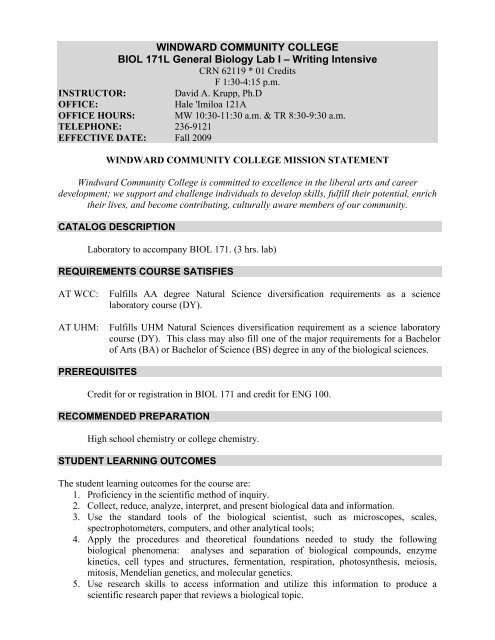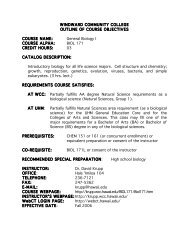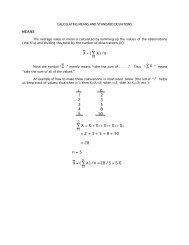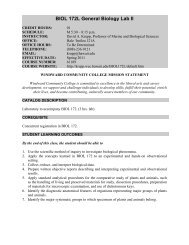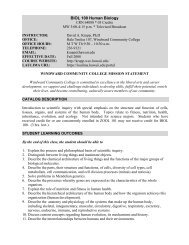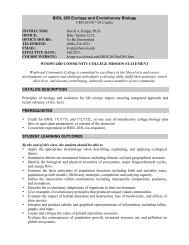Course Outline
Course Outline
Course Outline
Create successful ePaper yourself
Turn your PDF publications into a flip-book with our unique Google optimized e-Paper software.
WINDWARD COMMUNITY COLLEGEBIOL 171L General Biology Lab I – Writing IntensiveCRN 62119 * 01 CreditsF 1:30-4:15 p.m.INSTRUCTOR: David A. Krupp, Ph.DOFFICE:Hale 'Imiloa 121AOFFICE HOURS: MW 10:30-11:30 a.m. & TR 8:30-9:30 a.m.TELEPHONE: 236-9121EFFECTIVE DATE: Fall 2009WINDWARD COMMUNITY COLLEGE MISSION STATEMENTWindward Community College is committed to excellence in the liberal arts and careerdevelopment; we support and challenge individuals to develop skills, fulfill their potential, enrichtheir lives, and become contributing, culturally aware members of our community.CATALOG DESCRIPTIONLaboratory to accompany BIOL 171. (3 hrs. lab)REQUIREMENTS COURSE SATISFIESAT WCC:AT UHM:Fulfills AA degree Natural Science diversification requirements as a sciencelaboratory course (DY).Fulfills UHM Natural Sciences diversification requirement as a science laboratorycourse (DY). This class may also fill one of the major requirements for a Bachelorof Arts (BA) or Bachelor of Science (BS) degree in any of the biological sciences.PREREQUISITESCredit for or registration in BIOL 171 and credit for ENG 100.RECOMMENDED PREPARATIONHigh school chemistry or college chemistry.STUDENT LEARNING OUTCOMESThe student learning outcomes for the course are:1. Proficiency in the scientific method of inquiry.2. Collect, reduce, analyze, interpret, and present biological data and information.3. Use the standard tools of the biological scientist, such as microscopes, scales,spectrophotometers, computers, and other analytical tools;4. Apply the procedures and theoretical foundations needed to study the followingbiological phenomena: analyses and separation of biological compounds, enzymekinetics, cell types and structures, fermentation, respiration, photosynthesis, meiosis,mitosis, Mendelian genetics, and molecular genetics.5. Use research skills to access information and utilize this information to produce ascientific research paper that reviews a biological topic.
6.COURSE CONTENT2Concepts or Topics• Collecting data and making measurements• Descriptive statistics and presenting data• Accessing literature resources• How to write a scientific review paper• Biological molecules• Using the microscope• Diversity of cells and cell structure• Enzyme kinetics• Cellular respiration and fermentation• Light reactions of photosynthesis• Mitosis, meiosis and chromosomes• Mendelian genetics• DNA extraction and electrophoresis• The polymerase chain reaction (PCR)• BioinformaticsSkills or Competencies1. Maintain a laboratory notebook that adequatedocuments laboratory activities.2. Collect quantitative measurements and makecalculations (including conversions) using themetric system.3. Calculate averages and standard deviations.4. Perform simple statistical hypothesis testing.5. Present quantitative data in the form of tablesand graphs in the proper format suitable forpublication in a scientific journal.6. Use Excel software to compute statistics, createdata tables, and generate graphs.7. Draw figures illustrating observations andpresent these figures in a manner suitable forpublication in a scientific journal.8. Write summaries of laboratory activities,documenting these activities and demonstratingan understanding about the significance of theresults.9. Use information retrieval technologies toaccess literature sources for a research paper.10. Write a scientific research review paper and abiological topic.11. Use laboratory instruments: rulers, electronicscales, microscopes, spectrophotometers,respirometers, centrifuges, thermal cyclers,electrophoretic apparatus, etc.12. Demonstrating knowledge of the theoreticalprinciples involved, successfully carry out thefollowing analytical procedures: qualitativeanalyses of biological molecules, separation ofbiological compounds using chromatographyand electrophoresis, enzyme kinetics,preparation microscopic specimens forexamination (including proper staining),respirometry, photosynthesis, cultivation ofbacteria, extraction/measurement of nucleicacids, polymerase chain reaction,bioinformatics to analyze DNA sequences.13. Recognize different kinds of cells are theirstructures: protists, plant cells, animal cells,and bacteria cells.14. Recognize the stages of meiosis and mitosis inplant and animal cells.15. Predict parental and offspring genotypes andphenotypes using the principles of Mendeliangenetics.
COURSE TASKS, ASSESSMENT AND GRADING3LABORATORY NOTEBOOK. The student will maintain a laboratory notebook to record allnotes, observations, and information gathered before and during laboratory activities. Thisnotebook must be brought to every laboratory period. FAILURE TO BRING THE LABNOTEBOOK PROPERLY PREPARED FOR THE DAY’S LAB ACTIVITY WILLRESULT IN A 10 POINT REDUCTION IN THE STUDENT'S TOTAL POINTS FOREACH OCCURRENCE. This notebook will be collected and graded twice during the semester(30 points for the first collection; 30 points for the final collection; 60 points total). The type ofnotebook and the kind of information required will be explained during the introductory labsession.LABORATORY SUMMARIES. The student will complete a total of 12 written laboratorysummaries (20 points each). Each summary must be completed and turned in no later than thebeginning of the first laboratory meeting after the assignment was given (240 points total). Theproduction of laboratory summaries should be considered an individual student task. The sharingof data tables and graphs between students is considered a form of plagarism and isinappropriate. LATE SUMMARIES RECEIVED WITHIN ONE WEEK OF THE DUEDATE WILL BE ASSESSED AN AUTOMATIC PENALTY OF 3 POINTS. SUMMARIESWILL NOT BE ACCEPTED IF SUBMITTED MORE THAN ONE WEEK FOLLOWINGTHE DUE DATE.FORMAL RESEARCH REPORT. The student will complete a formal library research report(scientific review paper) on an approved biology topic in the form of a typical scientific reviewpaper. Development of this report will involve submissions of drafts and personal interviews todiscuss the development of these drafts towards the production of a final draft. Specific detailson the format of this report will be presented in class (100 points total). A LATE REPORTRECEIVED WITHIN ONE WEEK OF THE DUE DATE WILL BE ASSESSED ANAUTOMATIC PENALTY OF 20 POINTS. THE REPORT WILL NOT BE ACCEPTEDIF SUBMITTED MORE THAN ONE WEEK FOLLOWING THE DUE DATE.PRE-LAB QUIZZES. The student will take a total of 12 pre-lab quizzes (15 points each)administered via Laulima before the laboratory meetings. These quizzes will test the student'sknowledge of and preparation for the laboratory exercise planned for that day, as well as thestudent's understanding of the previous laboratory activity. In general, these quizzes will beposted on the WebCT site the Monday prior to the lab meeting. Access to the quiz will beprohibited beginning 30 minutes before the lab meeting. Of these 12 quizzes, only the 10 bestscores will be included in the student's point total (150 points total). NO MAKE-UP QUIZZESFOR ANY ABSENCES (EVEN RESULTING FROM LEGITIMATE ILLNESS) WILLBE ADMINISTERED.LABORATORY PRACTICAL EXAMS. The student will take two laboratory practicalexaminations (one midterm exam and one final exam; 100 points each) to demonstrateacquisition of laboratory skills and an understanding of information presented duringlaboratories.LABORATORY ATTENDANCE. Regular attendance is expected. Because laboratories involveconsiderable set-up/take-down time and supervision, students will NOT be able to make upmissed laboratory activities. A student missing a scheduled laboratory activity because of anillness or legitimate emergency may be given an alternative activity to make up lost lab summarypoints. In such a circumstance, the student is still responsible for the information presented
4during the missed laboratory session. Regardless of the reason, A STUDENT MISSINGMORE THAN TWO SCHEDULED LABORATORY SESSIONS WILL NOT RECEIVECREDIT FOR THE COURSE.LAB ATTIRE, CONDUCT AND HYGIENE. Because biology labs often involve working withhazardous materials and living organisms, students must dress appropriately. Students must wearlab coats and closed-toe shoes in the lab. Students may purchase a lab coat at the collegebookstore. In addition, some lab activities will require students to wear gloves and safety glasses(provided by the college). Students failing to dress appropriately for lab will not be permittedinto the laboratory and will be considered to be absent for the missed lab activity. Studentsengaged in conduct that threatens the safety of themselves and others in the lab will be refusedaccess to the lab for the remainder of the semester and will receive an “F” for the course.Students are also expected to clean up their workstations following the lab activities. Failing todo so will lead to a 5-10 point penalty depending upon the seriousness of the infraction.The assignment of points will be according to the following protocol:Practical ExaminationsQuizzesLaboratory NotebookLaboratory SummariesFormal Research ReportTOTAL200 points150 points60 points240 points100 points750 pointsLetter grades will be assigned as follows:ABCDFICRNC90% or above in total points and not missing more than one scheduled laboratoryactivity.80-89.9% of total points and not missing more than one scheduled laboratory activity.65-79.9% of total points and not missing more than one scheduled laboratory activity.55-64.9% of total points and not missing more than one scheduled laboratory activity.Below 55% of total points or informal or incomplete official withdrawal from course,or if a student misses more than one scheduled laboratory activity for reasons otherthan documented illness or emergency.Incomplete; given at the INSTRUCTOR'S OPTION when student is unable tocomplete a small part of the course because of circumstances beyond his or hercontrol. It is the STUDENT'S responsibility to make up incomplete work. Failure tosatisfactorily make up incomplete work within the appropriate time period will resultin a grade change for "I" to the contingency grade identified by the instructor (seecatalog); may be issued if documented serious illness or emergency forces a studentto miss more than one scheduled laboratory activity.65% or above in total points; the student must indicate the intent to take the course asCR/NC in writing by the end of the 10th week of classes (see catalog).Below 65% of total points; this grade only available under the CR/NC option (see
above and see catalog).5NWNOT GIVEN BY THIS INSTRUCTOR EXCEPT UNDER EXTREMELYRARE CIRCUMSTANCES (e.g., documented serious illness or emergency thatprevents the student from officially withdrawing from the course); may be issued ifdocumented serious illness or emergency forces a student to miss more than onescheduled laboratory activity; never used as an alternative for an "F" grade.Official withdrawal from the course after the third week and prior to the end of the10th week of classes (see catalog).Waiver of minimum requirements for specific grades may be given only in unique situations atthe instructor's discretion.Students involved in academic dishonesty will receive an "F" grade for the course. Academicdishonesty is defined in WCC's college catalog.LEARNING RESOURCESVanDeGraaff, K.M. J.L. Crawley. 2009. A Photographic Atlas for the Biology Laboratory,Revised Sixth Edition. Morton Publishing Company. 288 pp. (ISBN-13, 9780895828033)Descriptions of laboratory assignments and activities will be made available at the course Laulima siteand/or distributed in class.STUDENT RESPONSIBILITIESStudents should carefully review the attached sheet detailing inherently dangerous activities of thiscourse and sign the appropriate U.H. Assumption of Risk and Release and Medical Consent forms.Students are expected to participate in all laboratory activities and complete all course assignments ontime.Students are expected to be prepared in advance when they arrive to class. Being prepared includesthe following: having already read text materials (e.g., textbook readings and handouts) assigned forthat day's activities, bringing required work materials (e.g., lab notebook, textbook, handouts, writingsupplies, etc.), and having completed any assigned pre-lab tasks.Any changes in the course schedule, such as examination dates, deadlines, etc., will be announcedahead of time in class. It is the student's responsibility to be informed of these changes.It is the student's responsibility to be informed about deadlines critical to making registration changes(e.g., last day of erase period and last day for making an official withdrawal.The student should understand that BIOL 171L is a difficult course for students intending to major inone of the biological sciences. Thus BIOL 171L requires much time and serious dedication. If thestudent does not have a strong background or interest in science, the student does not belong in this labcourse.
BIOL 171L LABORATORY ACTIVITIES6Students enrolled in BIOL 171L are advised that certain required course activities are inherentlydangerous and may require normal physical abilities. Students are therefore required to readabout the inherently dangerous activities described below. In addition, students must read anddemonstrate knowledge of their responsibilities while engaged in these activities.Some students may have physical conditions that restrict their participation in certain laboratoryactivities. Respiratory ailments, certain allergies, and pregnancy may be among these conditions.Students exhibiting any of these conditions, or any other condition that may be impactedadversely by participation in the activity, should consult a physician.INHERENTLY DANGEROUS ACTIVITIES IN THE BIOLOGY LABORATORYStudents may be exposed to chemicals (e.g., formaldehyde, organic solvents, acids, and othercaustic chemicals), chemical fumes, laboratory equipment and supplies (e.g., scalpels, razorblades, glass slides, coverslips, and electrical equipment), toxic or irritating properties of livingand dead animals, human organic matter (e.g., saliva and blood), and other materials necessary tolaboratory activities of this or other laboratory classes. Other possible hazards include brokenglass on the floor or counters, combustible materials (e.g., bunsen burner gas), and slipperyspills.RESPONSIBLITIES OF STUDENTS IN THE LABORATORY1. Students should be familiar with safety procedures and take appropriate precautions atall times to insure the safety of every student in the lab.2. Students should follow instructions carefully, especially when hazardous conditionsoccur or hazardous materials are being used.3. Students should locate the placement of safety equipment and supplies in the laboratory:safety shower, eye wash station, fire extinguisher, and first aid kit. Students shouldunderstand the use of this equipment. Also note the locations of exits.4. Anyone injured in the lab, should inform the instructor immediately and take immediateaction to reduce the risk of further injury.5. Students should familiarize themselves with the fire procedures. Extinguish small fires,but leave the building immediately should a major fire occur. Notify the appropriateauthorities -- don't assume someone else remembered to do it. Meet with other studentsand your instructor outside the building before leaving so that an accurate headcountmay be made.6. Students should dress appropriately in the lab. Students may elect to supply their owngloves and protective aprons or laboratory coats. Some lab activities may requireprotective eyewear (provided for the activity by WCC).7. Students should report all hazardous conditions to the instructor immediately.
78. Chemicals may be poisonous, corrosive, or flammable. No chemicals, even chemicalsknown to be safe, should be ingested, inhaled, or touched unless specifically directed todo so by your instructor.9. All organisms, living or dead, should be treated with care and respect. Avoid directhandling when possible.10. The safe use of specific equipment and tools (e.g., microscopes, slides, scalpels, andpipettes) will be demonstrated by the instructor during the laboratory sessions. Studentsshould be sure they understand this usage.11. Students should clean up any supplies used and should return materials where theybelong as instructed. Any material spilled should be cleaned appropriately. Report andhazardous spills or breakages.12. Broken glass and sharp metal waste should be placed only in those receptacles markedfor such disposal -- do not put these materials in normal trash receptacles.13. Some chemical wastes may not be dumped into laboratory sinks. In such circumstancesan appropriate container will be provided for this waste in the lab.14. Organic waste resulting from animal dissection activities should be disposed of in theappropriate receptacle, not the ordinary trash receptacles.15. Human organic materials (e.g., saliva and blood) must be disposed of in such a way asto eliminate any possibility for contamination and the spread of disease. Appropriatehandling and disposal procedures will be explained when human materials are involvedin the laboratory exercise.16. Clean up the laboratory area: remove and dispose of all trash; return supplies andequipment to appropriate locations; and disinfect bench area.17. After completing laboratory activities and clean up, students should wash their hands inthe restroom to avoid spreading contamination and hazardous chemicals.18. The laboratory is a place for learning. Therefore, eating, drinking, and playing aroundis prohibited during the laboratory session. Students exhibiting unsafe or inappropriatebehavior in the lab may be asked to leave and may be given an "F" grade for the course.


